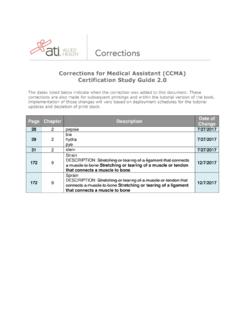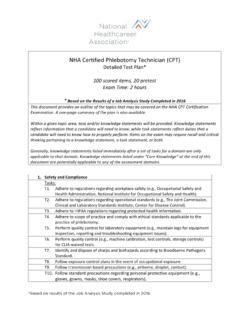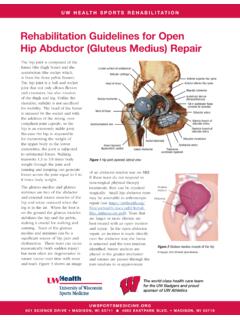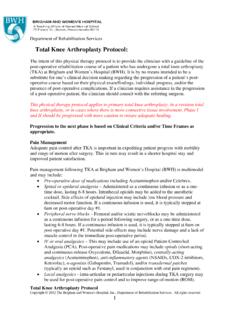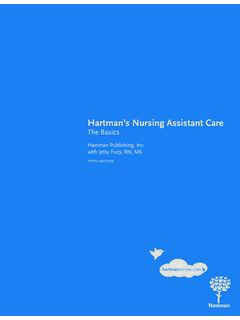Transcription of NHA Certified Patient Care Technician/Assistant (CPCT/A ...
1 NHA Certified Patient Care Technician/Assistant (CPCT/A) Test Plan 100 scored items, 20 pretest items Exam Time: 2 hours *Based on the results of a job analysis completed in 2018 This document provides both a summary and detailed outline of the topics and associated weighting that may be covered on the CPCT/A Certification Examination. The summary examination outline contains domains that are covered on the examination and the number of test items per domain The detailed outline adds to the summary outline by including tasks and knowledge statements associated with each task. Task statements reflect the duties that a candidate will need to know how to properly perform.
2 Knowledge statements reflect information that a candidate will need to know and are in support of task statements. Items on the examination might require recall and critical thinking pertaining to a knowledge statement, a task statement, or both. Summary CPCT/A Examination Outline DOMAIN # of Items on Examination 1. Patient Care 45 2. Compliance, Safety, and Professional Responsibility 20 3. Infection Control 11 4. Phlebotomy 14 5. EKG 10 Total 100 Domain 1: Patient Care 45 Items A. Provide basic Patient care under the direction of nursing staff ( , bathing, bed-making, catheter care, assisting with activities of daily living [ADLs], positioning). Supporting Knowledge 1.
3 Proper body mechanics 2. Patient bathing techniques ( , partial bath, sitz bath, full bed bath) 3. Oral care ( , denture care, special mouth care) 4. Perineal care ( , catheter care) 5. Foley catheter care 6. Types of Patient beds ( , closed, open, surgical, occupied) 7. How to operate Patient beds 8. Considerations in caring for patients who have functional limitations ( , physical, sensory, cognitive, or mental impairment) B. Provide emotional support for a Patient and family while performing Patient care. Supporting Knowledge 1. Therapeutic communication techniques 2. Culturally competent care 3. Positive and negative coping mechanisms C. Set up equipment to be used by a Patient ( , oxygen equipment, suction equipment, monitors).
4 Supporting Knowledge 1. Structure and function of body systems 2. Common disease processes ( , myocardial infarction, cardiovascular disease, congestive heart failure, diabetes, cancers in general, chronic obstructive pulmonary disease) 3. Oral suctioning 4. How to operate Patient beds 5. Oxygen delivery systems ( , rebreather masks, nasal cannula) D. Provide care for a Patient who has a feeding tube ( , take aspiration precautions, observe tubing for kinks or problems). Supporting Knowledge 1. Structure and function of body systems 2. Common disease processes ( , myocardial infarction, cardiovascular disease, congestive heart failure, diabetes, cancers in general, chronic obstructive pulmonary disease) 3.
5 Types of feeding tubes ( , percutaneous endoscopic gastrostomy [PEG] tube, gastrostomy [G] tube, nasogastric [NG] tube) 4. Considerations for patients who have feeding tubes ( , recognizing and reporting complications) 5. Aspiration precautions for patients who have difficulty swallowing ( , Patient positioning) E. Recognize and adapt approach to care for a Patient who has functional limitations ( , physical, sensory, cognitive, or mental impairment). Supporting Knowledge 1. Structure and function of body systems 2. Common disease processes ( , myocardial infarction, cardiovascular disease, congestive heart failure, diabetes, cancers in general, chronic obstructive pulmonary disease) 3.
6 Considerations in caring for patients who have functional limitations ( , physical, sensory, cognitive, or mental impairment) F. Report any changes in a Patient 's condition ( , level of consciousness, shortness of breath). Supporting Knowledge 1. Structure and function of body systems 2. Common disease processes ( , myocardial infarction, cardiovascular disease, congestive heart failure, diabetes, cancers in general, chronic obstructive pulmonary disease) 3. Signs and symptoms of changing Patient condition ( , loss of consciousness, shortness of breath, change to psychological or emotional state) G. Monitor and record functions related to bodily functions ( , urine output, emesis, bowel movements).
7 Supporting Knowledge 1. Structure and function of body systems 2. Common disease processes ( , myocardial infarction, cardiovascular disease, congestive heart failure, diabetes, cancers in general, chronic obstructive pulmonary disease) 3. Characteristics and measurement of expected and unexpected intake and output H. Perform ostomy care, excluding irrigation. Supporting Knowledge 1. Structure and function of body systems 2. Common disease processes ( , myocardial infarction, cardiovascular disease, congestive heart failure, diabetes, cancers in general, chronic obstructive pulmonary disease) 3. Ostomy care I. Assist with ostomy care. Supporting Knowledge 1.
8 Structure and function of body systems 2. Common disease processes ( , myocardial infarction, cardiovascular disease, congestive heart failure, diabetes, cancers in general, chronic obstructive pulmonary disease) 3. Ostomy care J. Monitor, record, and accurately measure intake and output ( , percentage of meal eaten, mL of fluid). Supporting Knowledge 1. Structure and function of body systems 2. Common disease processes ( , myocardial infarction, cardiovascular disease, congestive heart failure, diabetes, cancers in general, chronic obstructive pulmonary disease) 3. Characteristics and measurement of expected and unexpected intake and output K. Perform passive range-of- motion (ROM) exercises for a Patient .
9 Supporting Knowledge 1. passive ROM techniques L. Assist the Patient with adaptive devices for ADLs ( , feeding and dressing devices, ambulatory assistive devices). Supporting Knowledge 1. Structure and function of body systems 2. Common disease processes ( , myocardial infarction, cardiovascular disease, congestive heart failure, diabetes, cancers in general, chronic obstructive pulmonary disease) 3. Adaptive devices and their operation/use M. Perform Patient rounding ( , check for consciousness, breathing, positioning). Supporting Knowledge 1. Signs and symptoms of changing Patient condition ( , loss of consciousness, shortness of breath, change to psychological or emotional state) 2.
10 Elements of Patient rounding ( , pain, positioning, personal needs, proactive ADLs) 3. Factors to consider when prioritizing Patient needs ( , fall risk, elopement risk, rapid responses, stat laboratory values) 4. Hospital Consumer Assessment of Healthcare Providers (HCAHPS) N. Remove peripheral IVs. Supporting Knowledge 1. IV discontinuation process and techniques O. Assist in sterile and aseptic dressing changes. Supporting Knowledge 1. Aseptic and sterile dressing techniques P. Assist a Patient with ambulation. Supporting Knowledge 1. Purpose and use of a gait belt Q. Transfer a non-weight-bearing Patient ( , stretcher to bed). Supporting Knowledge 1.
